-
Welcome back Guest! Did you know you can mentor other members here at H-M? If not, please check out our Relaunch of Hobby Machinist Mentoring Program!
You are using an out of date browser. It may not display this or other websites correctly.
You should upgrade or use an alternative browser.
You should upgrade or use an alternative browser.
Work bench?
- Thread starter andrewgr
- Start date
I totally understand you safety concerns as me and my wife are in a similar situation. I did this prior to covid and this could be done with a phone call. The lumber yard also offered to deliver it and I rented a truck instead. I was able to haul it up the slope to my shed using a hand truck and tie downs.
For my remolded shed to shop conversion I wanted a good solid wood work bench that was a little deeper than off the shelf stuff. So I had a local lumber yard glue up 5 pieces of southern yellow pine milled to 1 ¾“x27 ½”x12' which I cut to a final length of 10'.
I wanted a solid wood surface that provides somewhat of a cushioned surface, if I drop or set something down a little heaver than planned, so it will not ding up what I am working on. A bench in my opinion is made to be worked on and so what if it absorbs a little oil and grease with a ding here or there which just adds some character to it.
I secured it to a 2x4 frame nailed to the wall's in one corner of my shop with E-Z Lok 400-4 brass threaded inserts (1/4"-20 Internal Threads, 0.500" Length) screwed into the bottom of the top spaced about 2' apart around the perimeter. The hole for the bolt through the bottom of the 2x4's is 3/8” diameter which gives it some room for wood movement since my shop is not a air conditioned or heated space except in the winter time with a small oil filled heater.
So far no splitting or cracking of the top with just a slight cupping down the middle. I love having the extra length an depth as it is a pleasure to work on.
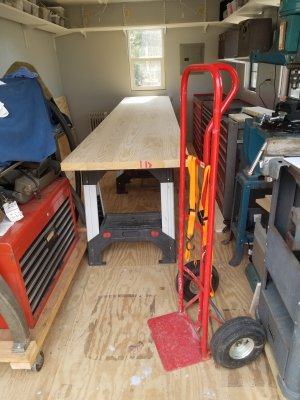
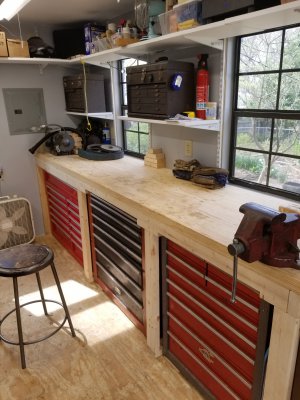
For my remolded shed to shop conversion I wanted a good solid wood work bench that was a little deeper than off the shelf stuff. So I had a local lumber yard glue up 5 pieces of southern yellow pine milled to 1 ¾“x27 ½”x12' which I cut to a final length of 10'.
I wanted a solid wood surface that provides somewhat of a cushioned surface, if I drop or set something down a little heaver than planned, so it will not ding up what I am working on. A bench in my opinion is made to be worked on and so what if it absorbs a little oil and grease with a ding here or there which just adds some character to it.
I secured it to a 2x4 frame nailed to the wall's in one corner of my shop with E-Z Lok 400-4 brass threaded inserts (1/4"-20 Internal Threads, 0.500" Length) screwed into the bottom of the top spaced about 2' apart around the perimeter. The hole for the bolt through the bottom of the 2x4's is 3/8” diameter which gives it some room for wood movement since my shop is not a air conditioned or heated space except in the winter time with a small oil filled heater.
So far no splitting or cracking of the top with just a slight cupping down the middle. I love having the extra length an depth as it is a pleasure to work on.


Last edited:
- Joined
- Sep 1, 2020
- Messages
- 794
@andrewgr im not sure if this really helps but this is an interesting topic and an important one. Many very good points and ideas have been presented. I have been reading and learning. Besides all that, from a hobby perspective it's fun!
i built some crummy wooden benches which worked fine. I kept building them stronger and they got heavy and expensive when scrapped materials could not be used. I find that a strong wooden bench while excellent is heavy for its strength and uses a lot of volume. I just divested myself of one I built that was 36x96" and used 6x6 posts, 2x6 stringers And 3/4" plywood. It had built in cabinets and new resides in my son's barn with a 5" Charles Parker vise I fixed up for him. that bench used too much room for what I began to need (I built it near 25years ago) and it is so heavy as to be nearly immovable.
I have used my oldest bench since I was 13 years old and was handed on to me by my father in 1983. It was old in the 1970s and while I hope to restore it, it is a centerpiece in my shop.
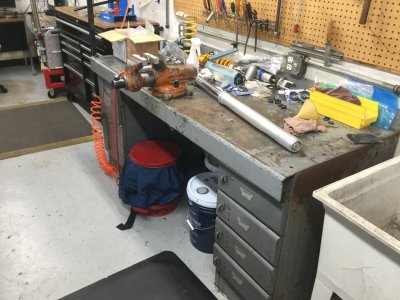
I like steel in benches because of the strength they provide vs the volume and weight of construction.
The last wooden bench I built that still survives in the shop is a bit of a catch-all that includes a granite plate...
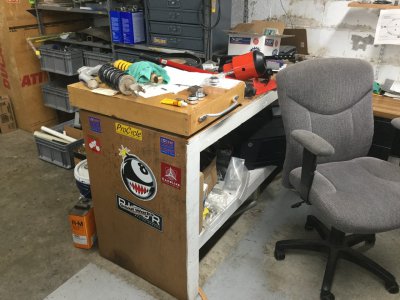
the specific design I recommended I have purchased used and new. This one includes an "inlet" steel plate for the corner vise (the best location in my opinion) as mentioned by a previous poster. This bench was given to me and I could have had 3 of them but for my lack of space.
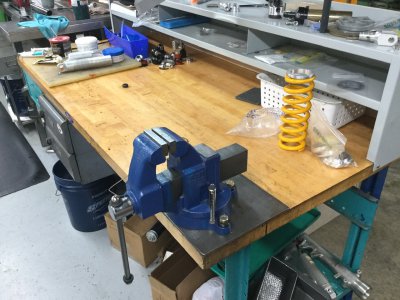 For welding and heavy beating on stuff I built a steel bench made from a 1/2" thick steel plate I was given.
For welding and heavy beating on stuff I built a steel bench made from a 1/2" thick steel plate I was given.
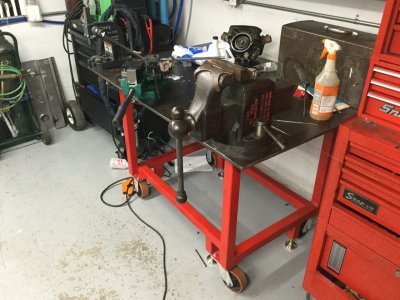
another used bench I won at auction replaced the wooded behemoth I mentioned earlier. It has a 43" height which I enjoy for standing and working. It uses the type of specific plywood top which is less expensive than the Maple ones. It's super strong but not as hard.
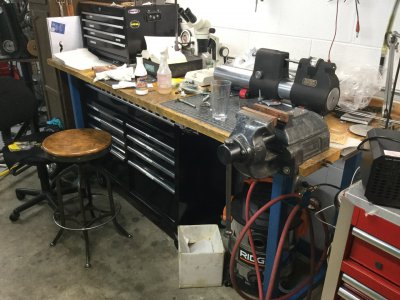
I agree with Bill regarding these things being personal and custom to your need. Your needs would be much different for tying flys than it would be for restoring old locomotive parts.
My most specialized and custom bench just for interested parties:
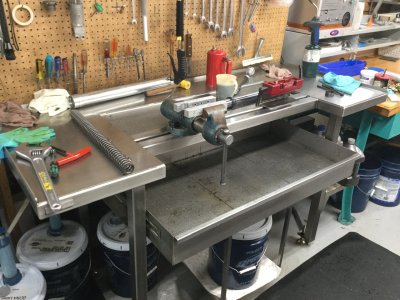
I have seen others use a salvaged solid core door and a set off saw horses to great effect so don't hesitate to do what's needed to produce what is arguably the most important tool in the shop!
my last photo to bore you with is a mail order purchased new bench like I originally suggested. Not inexpensive but something to be used for a lifetime or two.
i built some crummy wooden benches which worked fine. I kept building them stronger and they got heavy and expensive when scrapped materials could not be used. I find that a strong wooden bench while excellent is heavy for its strength and uses a lot of volume. I just divested myself of one I built that was 36x96" and used 6x6 posts, 2x6 stringers And 3/4" plywood. It had built in cabinets and new resides in my son's barn with a 5" Charles Parker vise I fixed up for him. that bench used too much room for what I began to need (I built it near 25years ago) and it is so heavy as to be nearly immovable.
I have used my oldest bench since I was 13 years old and was handed on to me by my father in 1983. It was old in the 1970s and while I hope to restore it, it is a centerpiece in my shop.

I like steel in benches because of the strength they provide vs the volume and weight of construction.
The last wooden bench I built that still survives in the shop is a bit of a catch-all that includes a granite plate...

the specific design I recommended I have purchased used and new. This one includes an "inlet" steel plate for the corner vise (the best location in my opinion) as mentioned by a previous poster. This bench was given to me and I could have had 3 of them but for my lack of space.
 For welding and heavy beating on stuff I built a steel bench made from a 1/2" thick steel plate I was given.
For welding and heavy beating on stuff I built a steel bench made from a 1/2" thick steel plate I was given.
another used bench I won at auction replaced the wooded behemoth I mentioned earlier. It has a 43" height which I enjoy for standing and working. It uses the type of specific plywood top which is less expensive than the Maple ones. It's super strong but not as hard.

I agree with Bill regarding these things being personal and custom to your need. Your needs would be much different for tying flys than it would be for restoring old locomotive parts.
My most specialized and custom bench just for interested parties:

I have seen others use a salvaged solid core door and a set off saw horses to great effect so don't hesitate to do what's needed to produce what is arguably the most important tool in the shop!
my last photo to bore you with is a mail order purchased new bench like I originally suggested. Not inexpensive but something to be used for a lifetime or two.
Attachments
- Joined
- Mar 26, 2018
- Messages
- 8,666
If you want to just buy one.
Global Industrial.
I had one like this I lost in the fire
 www.globalindustrial.com
www.globalindustrial.com
Global Industrial.
I had one like this I lost in the fire
Industrial Workbenches with Storage Options - Drawers & More
Preconfigured workbenches offer ready-to-use solutions with storage options like drawers and shelves. Improve workspace efficiency with our workbenches.
- Joined
- Jul 31, 2020
- Messages
- 765
I miss the days when hardware/lumber stores used to sell a very stout kit of supplied wood and plans to make a super-stout table constructed of 2 by 4s and 4 by 4's for the home use. My dad built a couple of these kits and they were quite stout and well braced. Now they want to sell pre-made benches with a pathetic 1 inch butcher block top over sheet metal (with inflated weight ratings which are vague).
- Joined
- Oct 14, 2013
- Messages
- 1,294
For a first cut, butcher block and steel legs is a good call, with a shelf underneath tying the legs together. A cross brace in back will really notch up the stability. After a few years on it, evaluate your happiness and adjust!
Think hard about height! An ideal workbench (IMHO) can be worked on sitting on a shop stool. The vise height on the stool should be pretty high for close work. You may want.two vices (or more ;-) having a smaller one low and a big one.high is nice. Standing up, the top of the (big) vise wants to be at the bottom of a bent elbow for optimim sawing and filing.
Putting a woodworkers vise into the bench (with either milled flat faces or wood faces) can be really useful for holding stuff vertically and horizontally.
Having a place where your knees can go under with the stool is valuable!
Planning for cables and hoses over the back.is good, as is the "dont roll off the back" stop mentioned in an earlier post.
Outlets on the legs and the back wall are really nice!
Sent from my SM-G892A using Tapatalk
Think hard about height! An ideal workbench (IMHO) can be worked on sitting on a shop stool. The vise height on the stool should be pretty high for close work. You may want.two vices (or more ;-) having a smaller one low and a big one.high is nice. Standing up, the top of the (big) vise wants to be at the bottom of a bent elbow for optimim sawing and filing.
Putting a woodworkers vise into the bench (with either milled flat faces or wood faces) can be really useful for holding stuff vertically and horizontally.
Having a place where your knees can go under with the stool is valuable!
Planning for cables and hoses over the back.is good, as is the "dont roll off the back" stop mentioned in an earlier post.
Outlets on the legs and the back wall are really nice!
Sent from my SM-G892A using Tapatalk
- Joined
- Dec 18, 2019
- Messages
- 7,428
Please note, this particular item, although pictured with a maple top, does not include it. It comes with a 1.5" plastic top. Please read the fine print as to what is actually included. Not in anyway saying the product is bad, just that the pictures are misleading. I'd be happy to have either version, but to me maple is nicer, and probably more expensive.If you want to just buy one.
Global Industrial.
I had one like this I lost in the fire
Industrial Workbenches with Storage Options - Drawers & More
Preconfigured workbenches offer ready-to-use solutions with storage options like drawers and shelves. Improve workspace efficiency with our workbenches.www.globalindustrial.com
- Joined
- Sep 1, 2020
- Messages
- 794
If you were to purchase exactly what I showed in my last photo, the legs, lower shelf and back brace would run about $170 and comes flat packed but very easy to assemble. Depending on what top you chose figure $100 -300 bucks. Shipping is extra. The items I got were all made in the USA and are very sturdy.

 www.mcmaster.com
www.mcmaster.com
McMaster-Carr
McMaster-Carr is the complete source for your plant with over 595,000 products. 98% of products ordered ship from stock and deliver same or next day.

